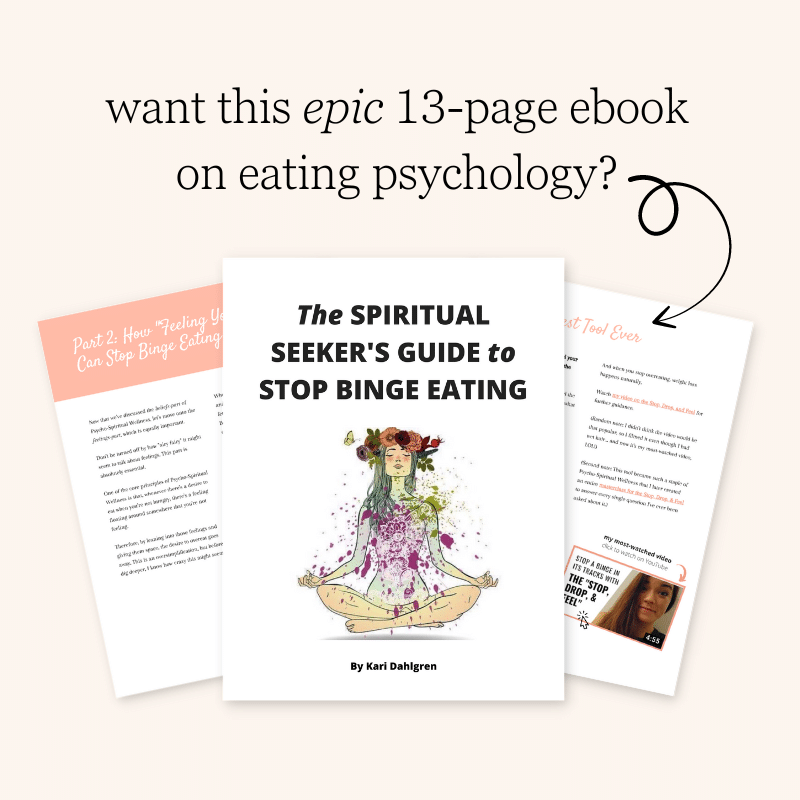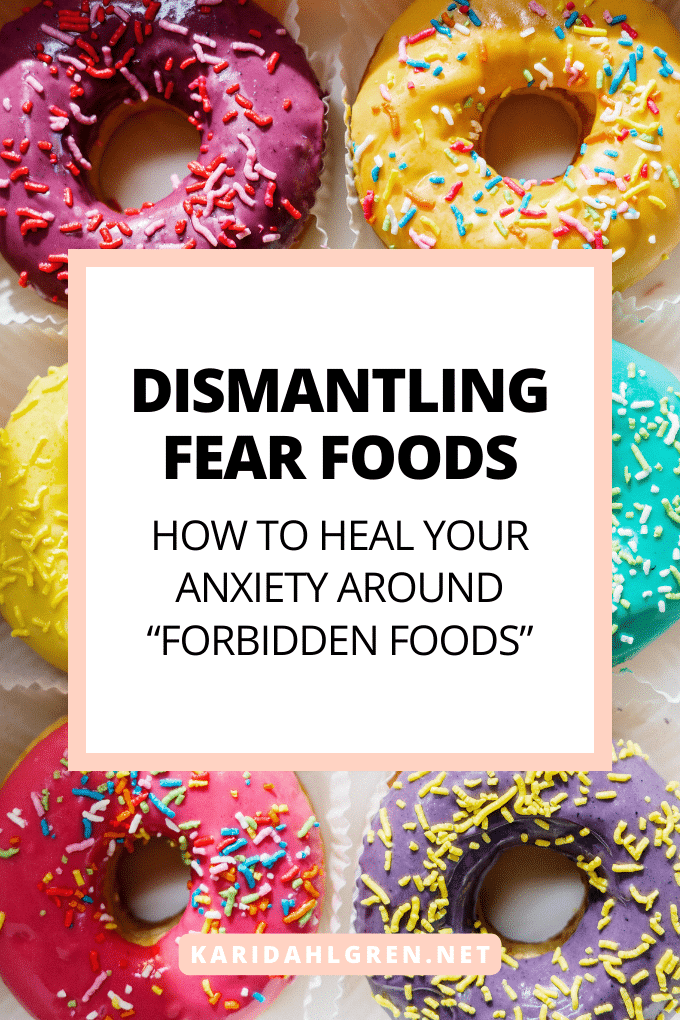
Fear foods, also known as ‘forbidden foods,’ are the foods that stir up intense anxiety – so much that we avoid them or feel extremely uneasy in their presence. Fear foods are the items that we often have conditioned ourselves to avoid due to diet trends or stigma about certain foods—especially carbs, sugar, and fat.
The fear of specific foods can stem from societal pressures (like diet culture), distorted nutrition information (largely due to diet culture), personal experiences, or eating disorders. Identifying and addressing fear foods is an essential part of healing your relationship with food and cultivating physical and mental wellness.
Let’s delve into an extensive exploration of fear foods, how we became so anxious around food (have I mentioned it yet: diet culture), and strategies to overcome them.
Understanding Fear Foods: Anxiety and Avoidance
Although I was never diagnosed with an eating disorder because I never reached out for help (and I should have!), my previous relationship with food was riddled with restriction, deprivation, binges, and so much shame.
My list of fear foods contained items high in sugar, fat, or dairy. Sour cream on my burrito? No way. Invitation to get some breakfast donuts? Can’t, I’m busy. Birthday brownies (because I don’t like cake) for the wonderful birthday girl and her friends? No chance. I was afraid that having one bite of anything would lead to more.
During my darkest days, though I was never formally diagnosed, I can say that my relationship with food became an eating disorder, as I would cancel plans with friends in order to avoid being around the “temptation” of food, and I would lock myself in my room – even though I wanted to be out – to keep forbidden foods out of my hands.
Since a defining factor for an eating disorder is functionality, it’s important to seek professional help if you find yourself canceling plans to avoid fear foods or missing work to compulsively exercise to “make up for bad foods” that were eaten.
When fear foods trigger behavior akin to extreme social anxiety (fear of being judged, fear of eating out in public, fear of being seen while eating) it’s time to reach out for help. I should have reached out to my therapist earlier than I did (by the time I made it to psychotherapy, my darkest days were thankfully already behind me) and it was one of the greatest decisions I ever made.
Origins and Influences of Fear Foods: A Cycle of Shame, Anxiety, and Restriction
Society tends to label foods as either “good” or “bad” based on how healthy they’re perceived to be. The world around us practically revolves around diet culture.
This judgment can trigger feelings of fear or guilt around certain foods, especially if you’re a highly sensitive person and do not like feeling judged. In fact, it is my opinion that most people with eating disorders are highly sensitive people, because food becomes a way of coping with the pressures of life that feel more intense to us than to others.
Furthermore, misinformation about nutrition can also add fuel to our fear foods. Take the ketogenic diet as an example, with its encouragement for a low-carb, high-fat intake, it’s easy to start developing unnecessary fear around foods rich in carbohydrates like bread and pasta.
Because the body needs carbs as a source of fuel, and the body deploys biological and hormonal changes to induce cravings for carbs when they are restricted, it can heighten the fear of binge eating fear foods.
To complete the vicious cycle, we restrict our intake of carbs more severely to make up for any binges, which only heightens the body’s response to restriction which makes us crave our fear foods even more. This all leads to a cycle of cravings, guilt, “giving in” to fear foods, and “tightening up ship” around them once more.
For many of my eating psychology coaching clients, they cannot fathom bringing forbidden foods into the house. When I ask how they feel about bringing just one of their fear foods in, they look at me with bug-eyes. Of course, I get it. Anyone who has fear foods knows the anxiety and shame that I am talking about.
Fortunately, there is a way to slowly ease your anxiety around forbidden foods or fear foods, and we will dig into them soon. Next, I want to really drive the point home of how diet culture is largely to blame for instilling fear around food.
Fear Foods Are Heavily Influenced by Diet Culture
The fear foods that were on my list might be similar to or wildly different than yours. While fear foods always vary among individuals, they commonly include foods high in fat, carbohydrates, or sugar – as all the latest diets tell us to cut them out; they are “bad for us.”
For example, from the 1960s all the way through the 1980s, the low-fat diet was touted as the most healthy diet available, and it was even promoted widely by physicians. Back then, fat was a common fear food among most people, and foods that were largely popular among dieters included fat-free or low-fat cookies and cakes.
These days, the high-fat and low-carb diets have taken center stage, and many of us now have carbs and sugar on our list of fear foods.
While pretzels were once a “good food” in the 1970s during the low-fat era, they are now considered by many to be a “bad food.”
Foods such as bread, pasta, rice, potatoes, chips, and sweets are often feared due to their carbohydrate or sugar content. This can result in avoidance of these foods, leading to restrictive diets that perpetuate the restrict-binge cycle, and the potential for nutritional deficiencies.
Furthermore, the fear and avoidance of forbidden foods can disrupt a person’s ability to maintain a balanced diet, potentially impacting their physical health and mental well-being. For example, carbohydrates are our body’s primary source of energy, and avoiding them can lead to fatigue, poor concentration, and mood swings.
When Does a Fear of Food Become an Eating Disorder?
Avoidant/Restrictive Food Intake Disorder (ARFID), also previously known as Selective Eating Disorder, goes beyond a mere aversion to certain foods. It is an eating disorder characterized by a stringent avoidance or restriction of specific foods. This isn’t due to a fear of gaining weight, as in the case of anorexia nervosa, where individuals avoid food or eat only very small quantities due to distress about their body shape, size, or fears of ‘fatness.’
With ARFID, individuals’ dietary limitations are driven by a fear of the sensory characteristics of foods such as taste, smell, texture, color, or temperature, or by a previous negative experience like choking or vomiting. For instance, it is not simply an aversion to fried foods, but an intense avoidance to the extent that if a fried food were touching any other food on a plate, all the ‘contaminated’ food would be avoided as well. Essentially, it’s a condition where an individual would rather starve than consume a fear food.
This illustrates how fear and avoidance of food can spiral into an eating disorder, a condition that comes with serious, sometimes fatal consequences. Anorexia nervosa, for instance, carries an incredibly high mortality rate compared to other mental disorders. It isn’t just about self-starvation and an unhealthy obsession with body weight; people with anorexia are at a real risk of dying from the severe medical complications that come along with starvation.
Don't let yourself or anyone you care about grapple with these fears and their consequences alone. If you or someone you know is wrestling with thoughts of suicide, please, reach out to the 988 Suicide & Crisis Lifeline. You can call or text them at 988.
Strategies for Overcoming Fear Foods and Embracing Food Variety
Embracing food variety and challenging the concept of fear foods is a crucial step in managing eating disorders and fostering a healthier relationship with food. This means moving away from restrictive eating patterns that label foods as strictly “good” or “bad” and adopting a more intuitive, balanced approach.
By reframing our perspective on fear foods and understanding their place in a diverse and balanced diet, we can dismantle harmful eating behaviors and encourage nutritional variety. Pretzels and ‘full-fat’ cookies can both be included in a well-balanced and healthy diet!
Here are some in-depth strategies that you can take to slowly reduce anxiety around fear foods and eventually make peace with them:
1. Gradual Exposure
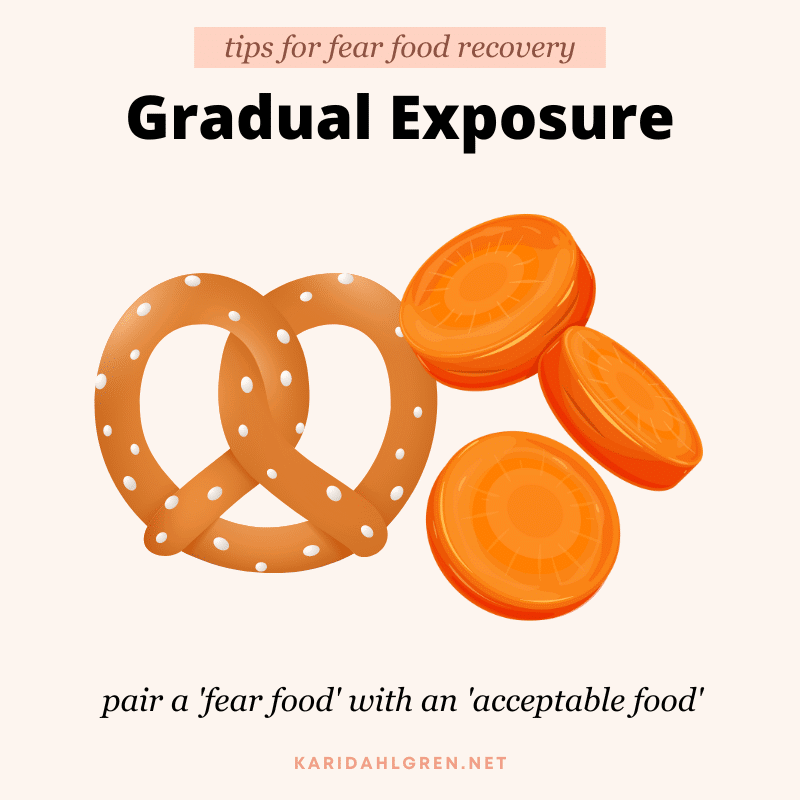
Gradual exposure and food challenging techniques can both be effective in overcoming fear foods. This approach involves introducing fear foods into your diet in a slow, controlled, and manageable manner. By starting with small portions and gradually increasing the amount, you can desensitize yourself to the anxiety and fear associated with these foods.
One way to implement gradual exposure is to pair a fear food with an ‘acceptable’ food. For example, if pretzels are on your list of fear foods, perhaps you can add a tiny handful to a meal that contains other foods that you really like and feel safe with. Start really small and pay close attention to your anxiety (more on this later).
2. Food Challenging Techniques
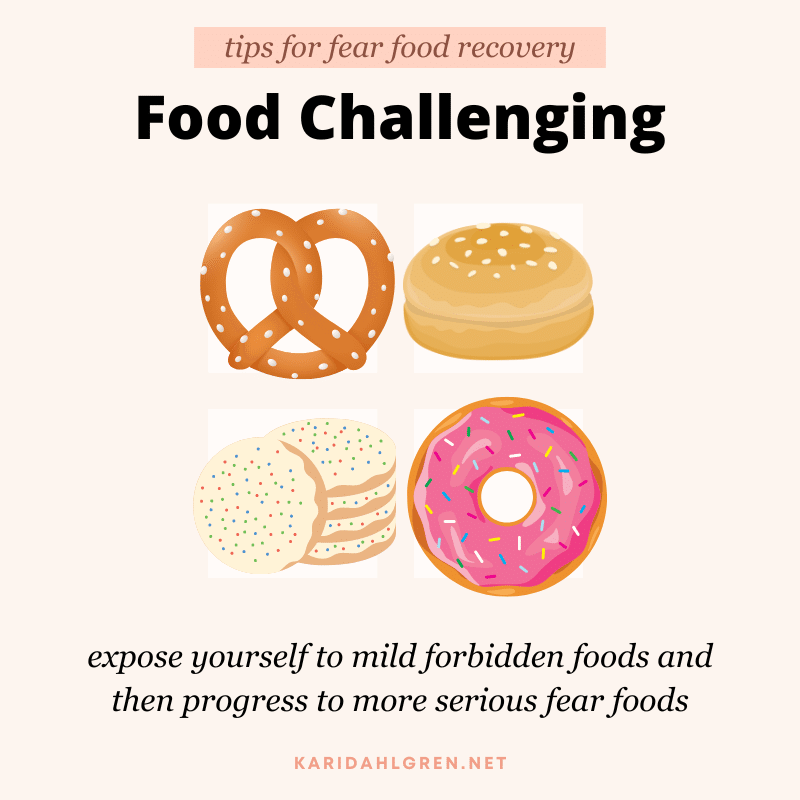
When you’re ready for more challenge, you can try food challenging techniques like so:
- Create a Fear Food Hierarchy: Begin by making a list of your feared foods and categorize them into different levels of fear – such as slight, moderate, or severe anxiety. Or you can number them on a scale of 1-10. However you choose to systematize it, your chart will help you prioritize and plan your exposures.
- Start with Slightly Anxious Foods: Choose a fear food from the low end of the scale that feels manageable but still slightly challenging.
- Plan and Carry out Exposures: Incorporate the fear food into a normal meal or snack, ensuring you have a plan that feels supportive and comfortable. Consider choosing a day when you feel more confident or have company to provide additional support. Gradually increase the exposure frequency and portion size over time.
- Keep Records: Keep a record of your exposures, including the date, the food eaten, and your anxiety rating on a scale from 0 to 10. This record helps you track your progress, identify patterns, and celebrate your achievements.
- Gradually Move Up the Hierarchy: As you gain confidence and experience success with exposures from the low end of the scale, gradually work your way up to the more anxiety-provoking fear foods on your list. Take your time and progress at a pace that feels comfortable for you.
It’s important to note that this process can be challenging and may require support from a therapist or healthcare professional specializing in eating disorders. They can guide you through the gradual exposure process, provide emotional support, and help you navigate any difficulties that arise along the way.
3. The Stop, Drop, & Feel Method: Using Emotional Tolerance to Quell Anxiety Around Food
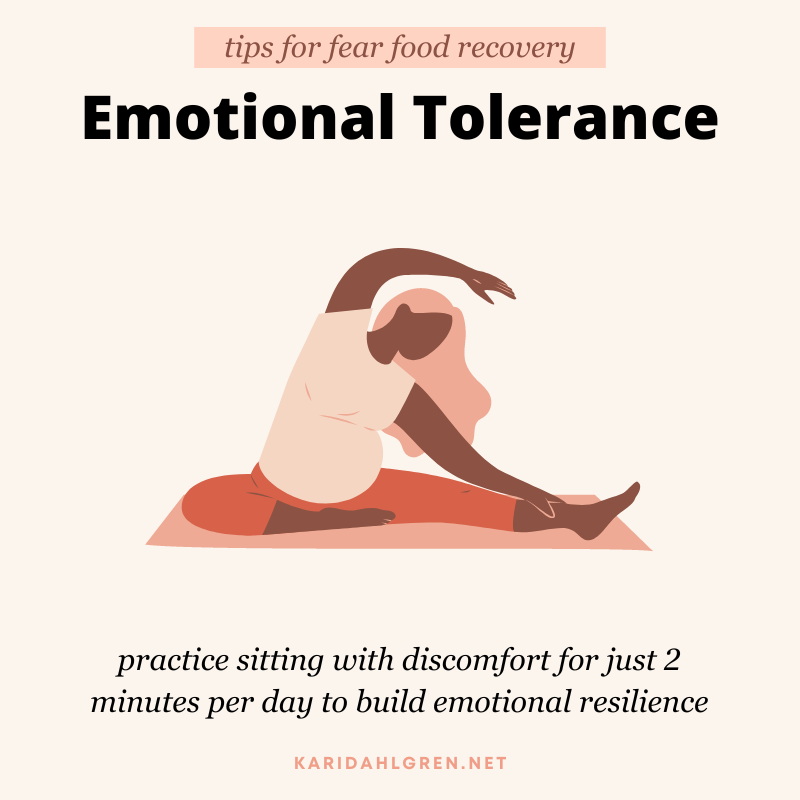
Gradual exposure and food challenging techniques are common and classic treatments for eating disorders, and if you have an eating disorder or suspect that you do, I highly recommend reaching out to a specialist.
For anyone that does not have an eating disorder but still finds “bad foods” scary – perhaps you keep them out of the house completely, but you don’t lock yourself in your room to avoid them – the following technique can help. I call it the Stop, Drop, & Feel.
While my Stop, Drop, & Feel method is typically used to help with binge eating, it can be a valuable tool in overcoming fear foods and developing emotional tolerance. This technique can assist you in navigating the anxiety and discomfort that fear foods often evoke.
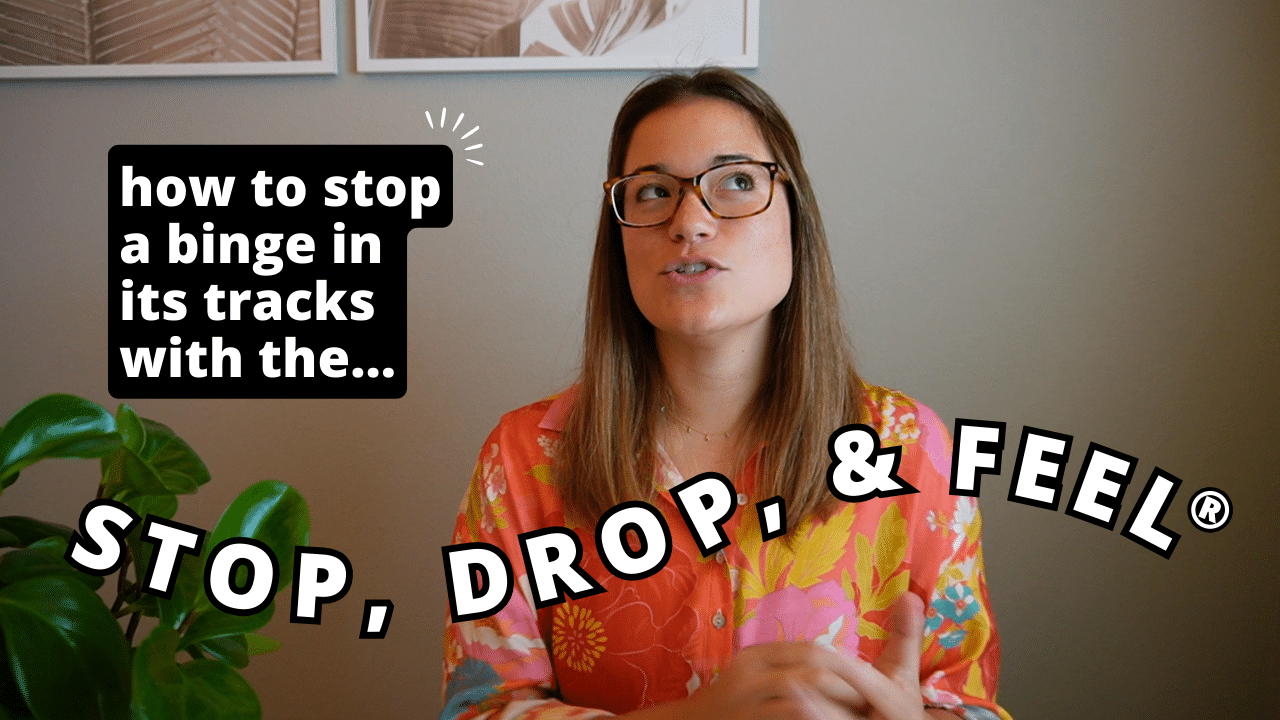
Before confronting a fear food, start by employing the Stop, Drop, & Feel method:
- Stop what you are doing: Pause and take a moment to acknowledge your intention to challenge a fear food. Recognize any apprehension or anxiety that may arise. It is very likely that you will feel uneasy or extremely anxious when attempting to eat a forbidden food, and that is okay.
- Drop into your emotions: Shift your attention inward and drop into your body. Allow yourself to fully experience any physical sensations, emotions, or thoughts that emerge. Instead of resisting any anxiety that comes up, just make space for it to exist. Resisting emotion only makes it stronger, so the Stop, Drop, & Feel really focuses on surrender and allowing yourself to just be.
- Feel: Most of us will feel edgy, to say the least, when confronting fear foods. The goal of the Stop, Drop, & Feel is to gain practice in feeling that edginess and anxiety. When you repeatedly expose yourself to these emotions – and you practice feeling them instead of resisting them – you develop a skill that I call emotional tolerance.
Emotional tolerance is your ability to feel uncomfortable without getting swept into compulsions (and avoiding fear foods is usually a compulsion). Like all skills, you get better at it over time. I recommend doing the Stop, Drop, & Feel for just 2 minutes a day. That’s all you need – and it’s also just about all I can personally stand, too!
Although it might not seem like much, exposing yourself to anxiety for just 2 minutes a day is a gentle way to develop tolerance for it. Even though the thought of bringing cookies into the house, for example, fills you with anxiety now; training in tolerating anxiety will eventually help you feel less anxious at the thought of bringing some fear foods inside.
Eventually, you will be able to confront your fear foods without feeling like it’s confrontation at all. It does not happen overnight, but as someone that once canceled plans to avoid being around my fear foods, I can attest to the power of emotional tolerance and the Stop, Drop, & Feel.
4. Cognitive Behavioral Techniques for Fear Foods
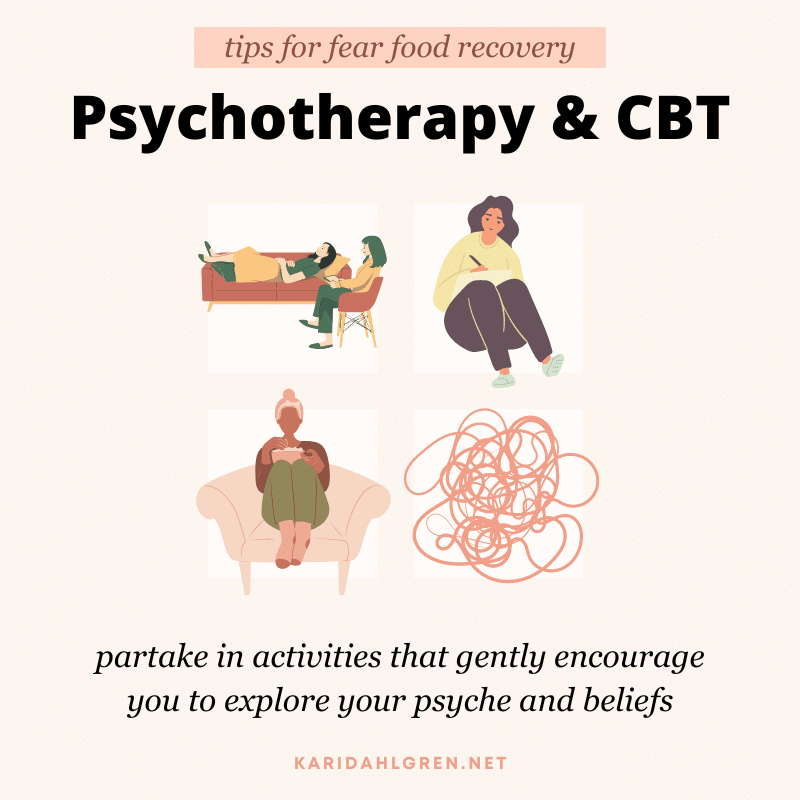
Psychotherapy, particularly cognitive-behavioral therapy (CBT), is another powerful tool in addressing fear foods and making peace with food. Working with a therapist who specializes in eating disorders can provide invaluable support and guidance throughout the recovery process. Even a therapist that does not specialize in eating disorders can provide a wealth of support and compassion on your journey.
Here are a few concrete examples of how cognitive-behavioral therapy techniques can be applied to fear foods:
- Exposure Therapy: Exposure therapy (as discussed above) is an effective technique for gradually confronting fear foods in a controlled and supportive manner. Food challenging techniques are even more effective with the guidance of a therapist.
- Cognitive Restructuring: Cognitive restructuring involves identifying and challenging negative thoughts and beliefs about fear foods. A therapist can help individuals recognize irrational or distorted thinking patterns and assist in reframing them with more realistic and balanced thoughts.
- Mindful Eating: Mindful eating involves paying close attention to the sensory aspects of eating, such as taste, texture, and smell, while also being aware of emotions and thoughts that arise during the eating experience. By practicing mindful eating, individuals can develop a more balanced and non-judgmental relationship with food, including fear foods.
- Self-Monitoring: Self-monitoring involves keeping a record of eating behaviors, emotions, and thoughts related to fear foods. This process helps individuals gain insights into patterns and triggers, and it provides a basis for discussion and exploration with a therapist. Self-monitoring can also increase self-awareness and accountability, empowering individuals to make conscious choices and identify areas for growth.
Again, if you suspect that you have an eating disorder, it’s important to get help and a diagnosis from a qualified health professional such as a registered dietitian or therapist. Many of my eating psychology coaching clients work with both me and a therapist simultaneously, which provides a well-rounded approach to making peace with food.
5. Nutritional Education
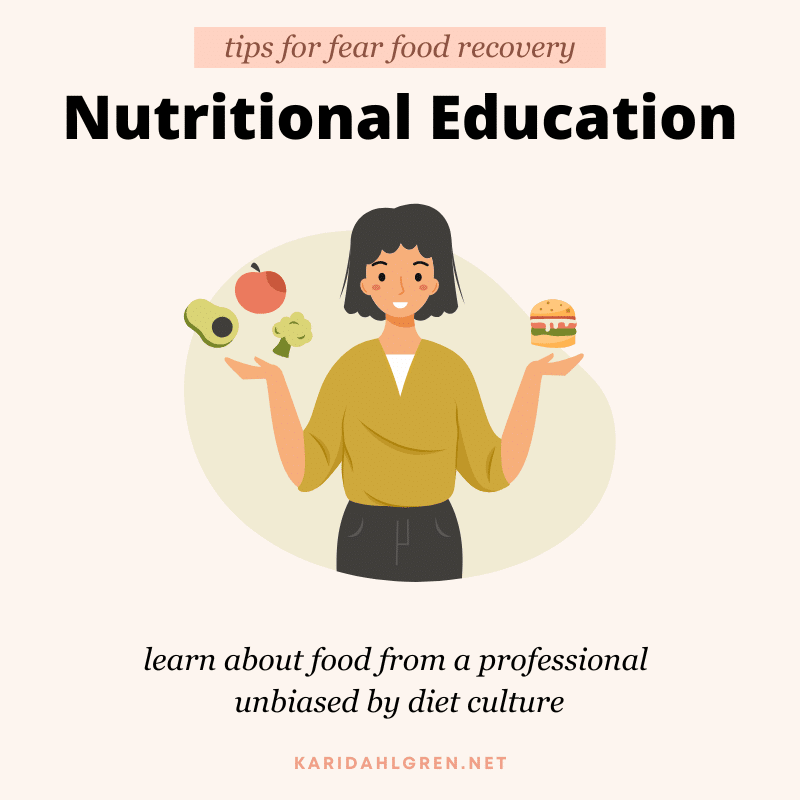
Nutritional education is an essential component of overcoming fear foods and developing a balanced relationship with food. By debunking common food myths and understanding the principles of a balanced diet, individuals can make more informed food choices that support their overall health.
Let’s say someone has a fear of carbohydrates due to the common belief that they automatically lead to weight gain. Through nutritional education, they can learn about the role of carbohydrates in providing energy for the body, the different types of carbohydrates (such as complex and simple), and the importance of including them in a balanced diet.
They may discover that carbohydrates are a crucial fuel source for physical and mental activities, and that they play a role in maintaining stable blood sugar levels and supporting brain function. With this newfound knowledge, they can begin to challenge their negative beliefs about their fear foods and make more informed choices.
Reducing Anxiety Around Fear Foods
Overcoming fear foods and embracing food variety is a journey towards achieving a healthier relationship with food. This process is unique to everyone, and progress might be slow, but with perseverance, professional guidance, and a healthy dose of patience, we can make peace with our fear foods.
I hope you’ve enjoyed my transparency in that, while I love coaching people through the challenges of compulsive eating, I am not equipped to help with eating disorders. I provided plenty of links and resources in this article to help you get the right type of help for you.
If you’re interested in learning more about my unique approach to stopping compulsive eating, check out my free ebook below:

